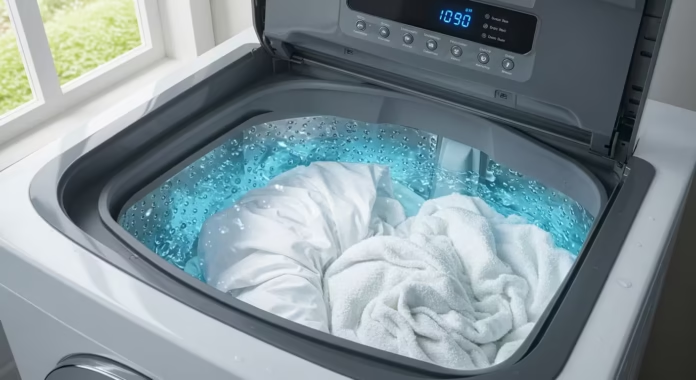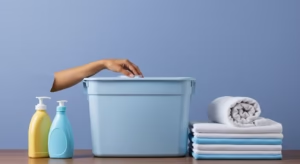Laundry can feel like an endless chore, so combining loads might seem like a tempting time-saver. But if you’ve ever wondered, Can you wash sheets and towels together?, the short answer is “not usually.” While it can be done in some circumstances, mixing sheets and towels in the same wash cycle is generally not recommended. Why? Differences in materials, washing requirements, and hygiene concerns can all negatively impact the cleanliness and longevity of your linens.
This guide explores why sheets and towels shouldn’t typically share the washing machine, best practices for caring for each, and solutions to common laundry issues like musty smells. Ultimately, following these tips will ensure your linens are fresh, clean, and long-lasting.
Understanding the Differences Between Sheets and Towels
To fully understand why washing sheets and towels together is discouraged, it’s essential to examine their differences in material, usage, and washing needs.
Material and Texture
Sheets are typically made of smooth fabrics like cotton sheets, percale, or sateen, woven to provide comfort and softness. Towels, on the other hand, are made from terrycloth or microfiber, designed for high absorbency and durability. These differences mean towels shed lint during washing, which can stick to your smooth bath sheets, making them appear worn or spoiled.
Usage and Dirt Levels
The purpose and frequency of use also influence how dirty sheets and towels get:
- Sheets collect skin cells, sweat, body oils, and dust mites over nights of use.
- Towels are exposed to more moisture, leading to bacteria and potential mildew. Shared or improperly dried towels are even more likely to hold onto germs.
This difference in dirt levels means that combining sheets and towels can lead to cross-contamination, reducing how clean they get.
Washing Needs
The differences in fabric type also affect washing requirements:
- Sheets require gentler cycles to maintain their delicate texture.
- Towels, being thicker and more absorbent, need longer, heavier wash cycles to thoroughly clean their fibers.
- Towels usually require higher water temperatures to kill bacteria, while some sheets (like microfiber or satin) may not tolerate those temperatures.
Why You Shouldn’t Wash Sheets and Towels Together
Now that we’ve explored how sheets and towels differ, here are the main reasons why they shouldn’t typically share the same load.
Contamination
When you wash towels, any bacteria or mildew trapped in their fibers can transfer onto your sheets. While hot water and detergent can kill most bacteria, it’s still important to wash these items separately to reduce the overall risk of cross-contamination. For example, learning how to wash microfiber towel materials properly, separately and with care, can help preserve their quality and prevent the spread of germs to other laundry.
Lint Issues
Towels are notorious for shedding lint because of their textured weave. When washed together, this lint can stick to your sheets, causing them to look dingy and feel less smooth. Over time, this buildup can ruin your sheets’ appearance and comfort.
Compromised Cleaning
Washing sheets and towels together can impact how thoroughly they’re cleaned. Towels absorb more water during the cycle, leaving less water and detergent to clean your sheets effectively. Similarly, the heavy weight of towels can create tangles in the load, preventing even washing and rinsing.
By separating sheets and towels, you’ll achieve optimal cleanliness, ensure fabrics last longer, and avoid unnecessary issues like lint transfer and odor retention.
Best Practices for Washing Sheets
Properly caring for your sheets ensures they remain soft, fresh, and in excellent condition. Here’s how to wash them right.
Temperature
Wash sheets in warm water (between 90–110°F) to effectively remove dirt, bacteria, and sweat without damaging the fabric. For heavily soiled sheets, hot water (130°F) may be used, as long as the care label allows it.
Detergent
Opt for a mild, high-quality detergent designed to preserve fabric color and texture. Avoid overloading the washer, as sheets need space to rinse thoroughly without residues.
Frequency
Wash sheets weekly. If you tend to sweat more or sleep with pets, consider bi-weekly washes for better hygiene.
Best Practices for Washing Towels
To keep your towels soft, fresh, and absorbent, follow these expert tips.
Temperature
Wash towels in hot water (130–140°F) to effectively kill bacteria, especially for shared bath towels. For colored towels, make sure the fabric can handle high heat by checking the care label.
Detergent
Use a detergent formulated for deep cleaning and stain removal, as towels are often exposed to makeup, sweat, and body oils. Add vinegar or baking soda for an extra boost:
- Vinegar helps remove odors and softens fibers.
- Baking soda neutralizes smells and prevents mildew buildup.
Frequency
Wash bath towels after 3–4 uses and hand towels more frequently. To prevent musty smells, hang towels to dry completely between uses and avoid leaving them in damp bathrooms.
Addressing Common Issues: Musty Towels
If your towels smell musty despite regular washing, here’s how to bring them back to life.
Causes of Musty Smells
Musty towels often result from insufficient drying, detergent residue, or mildew growth. Unfortunately, a standard wash cycle alone may not resolve this.
Solutions
-
Using Vinegar
Step 1: Place towels in the washer and add 1 cup of white vinegar (instead of detergent).
Step 2: Wash on the hottest water setting available.
Step 3: Rewash towels with detergent in a second cycle to remove all odors.
-
Using Baking Soda
Step 1: Add 1/2 cup of baking soda directly to the drum (not the detergent compartment).
Step 2: Wash towels in hot water with little or no detergent.
Step 3: Ensure towels are rinsed thoroughly before drying.
-
Drying Techniques
Proper drying is essential to prevent musty smells:
- Use the highest heat setting safe for your towels.
- For air-drying, hang towels in a sunny, ventilated area to dry quickly.
When It’s Okay to Wash Sheets and Towels Together
Despite general advice against it, there are rare occasions when washing sheets and towels together is acceptable:
- When Items Are New: If freshly purchased, neither sheets nor towels will contain significant dirt, bacteria, or lint.
- When Time Is Tight: If you’re in a hurry, run a combined load on a suitable cycle, ensuring water temperature is appropriate for both fabrics. Use a lint remover after drying to remove any residues.
Keeping Your Laundry Fresh and Hygienic
The next time you’re tempted to toss sheets and towels into the same wash, remember this guide! Separating these items may take a little extra time, but it’s worth it for better cleanliness, longer-lasting linens, and fewer laundry headaches. Stick to the best practices outlined above, and your laundry routine will reward you with fresh sheets and fluffy towels every time.

